Food for the Soul: “Expressionists: Kandinsky, Münter and the Blue Rider” Exhibition
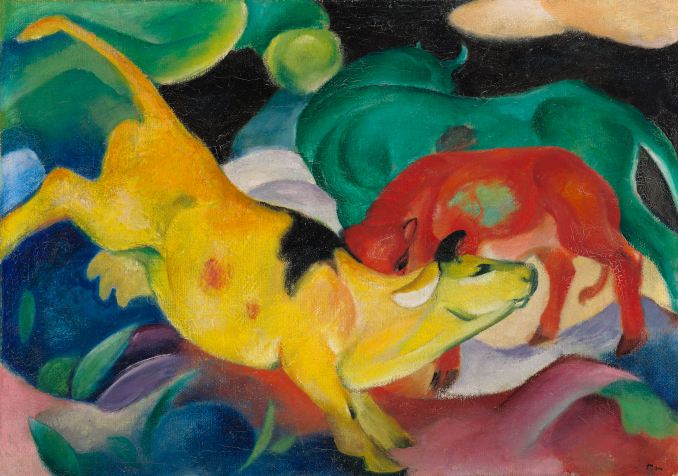
By Nina Heyn – Your Culture Scout
When we think of German Expressionism, the images that most readily come to mind are often the black and white lithographs of Berlin artists like Käthe Kollwitz or Erich Heckel, but in fact this art movement also encompassed paintings brimming with color brighter than anything that German art had seen before the early 1900s. Whereas Berlin, at that time, was a center of more somber, politically engaged, anti-establishment art, Munich was considered Germany’s art capital, where the new styles of Impressionism, Cubism, and Fauvism were studied. In 1896, a new art student arrived in Munich. Wassily Kandinsky was a 30-year old Russian lawyer who, a bit like Gauguin, decided in the prime of life that he wanted a radical change and became a painter. He spent 18 years in Munich, returning to Russia only after being expelled from Germany at the outbreak of WWI.
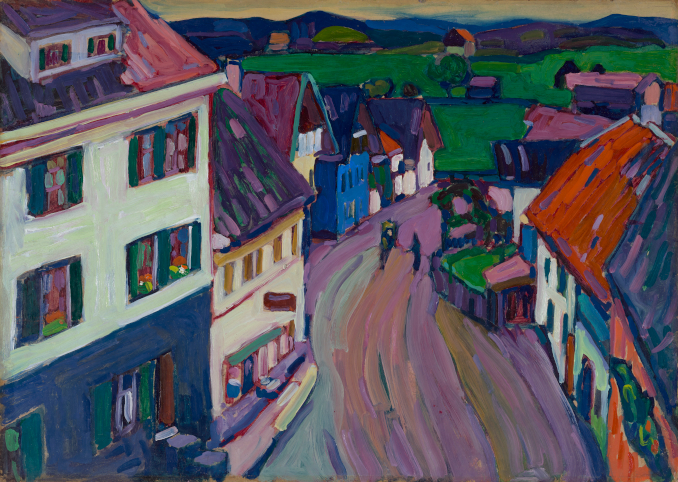
A man of huge energy and organizational skills, Kandinsky is credited as a creator of Der Blaue Reiter (The Blue Rider), an art movement that brought to German art an explosion of color. Kandinsky and his friend Franz Marc mounted two important exhibitions, published an art magazine, and—together with fellow Russian expatriate Alexej von Jawlensky and such artists as August Macke, Marianne von Werefkin, Paul Klee, Robert Delaunay, and Gabriele Münter—discussed and created a new art language. In their desire to make art that would articulate individual views of the world and herald changes in politics, technology, and social customs, the Blue Rider group was not different from their Berlin colleagues, but the language of their expression—wildly colorful, and increasingly abstract in content and line—went in a different direction.

This summer, Tate Modern in London has mounted a crowd-pleasing exhibition titled “Expressionists: Kandinsky, Münter and the Blue Rider.” The exhibition assembles some of the most iconic examples of the Blue Rider style in a thoughtful progression. For example, the show illustrates Kandinsky’s evolution from imaginary but “illustrative” images to abstract ones—the style that he pioneered.
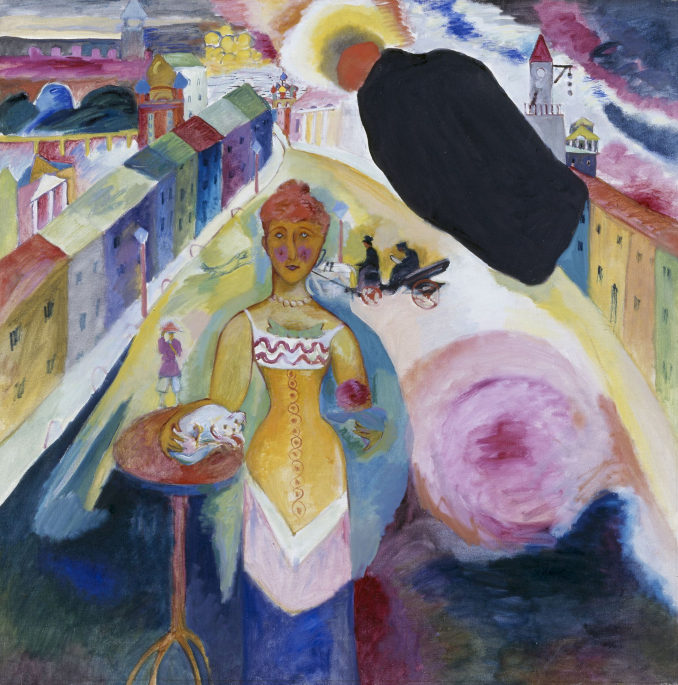
That revolutionary change in Kandinsky’s style took place while he was exploring the role of art in the fast-changing society of the early 20th century. His search for the new meaning of art and its ability to express the subconscious mind influenced all the artists in his group. One of the most striking images in the exhibition is the canvas, A Lady from Moscow, which is imbued with lyricism and maybe even nostalgia for Kandinsky’s home country, but at the same time it has surreal and disturbing elements. The most dramatic is a black blob that could perhaps be interpreted as a person, floating Chagall-style above the woman; but perhaps it could also be an explosion or a void—serving as a premonition of the changes and destruction awaiting Moscow in a short five years’ time, when the Russian Revolution would destroy the city, the noble ladies, and the whole way of life of Kandinsky’s youth. In any case, if at first glance this is an image of a lady with a cute white dog, a more careful examination of the picture reveals that the woman is missing an arm, with a gory stump of flesh protruding forward—even symbolically, this image evokes physical violence. Even if at the time Kandinsky was paying more attention to artistic theories and styles than any symbolic meaning, looking at this picture now, with all the historical knowledge, adds a new dimension.
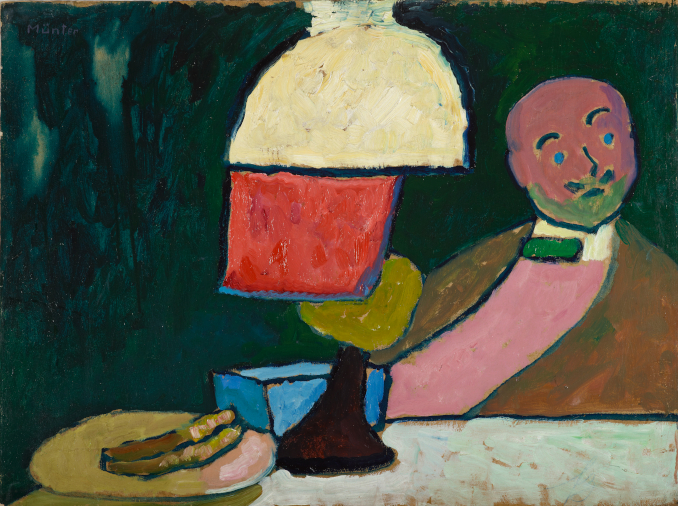
The Tate exhibition is particularly diligent in presenting artworks by the group’s female artists: Gabriele Münter, who was Kandinsky’s companion for many years, and Marianne von Werefkin, who joined the movement through Jawlensky.
Münter’s Listening is a perfect example of the group’s artistic style—visually arresting (and not necessarily realistic) planes of color and a simplification of forms that eventually would lead Kandinsky and others to abstract art.

Marianne von Werefkin—a noblewoman who rejected traditional Russian society by moving to Germany and living the bohemian life of an émigré artist—created a striking Self-Portrait, using bright contrasting hues and painting her irises orange. There is so much self-confidence and strength in this portrait; this is an emancipated woman who is sure of herself, despite the many disappointments that life served her. By 1909, von Werefkin was already halfway through her 27-year relationship with Alexej von Jawlensky—a Tsarist army officer who moved with her from Russia to Munich to pursue art. Werefkin put her own art development on hold for 10 years, funding and supporting Jawlensky’s studies. Moreover, she tolerated Jawlensky’s womanizing and his long-standing relationship with her maid that resulted in 1902 in the birth of his son. Being part of the Blue Rider circle of friendships and artistic pursuits must have been more important for her than the unusual dynamics of her household.
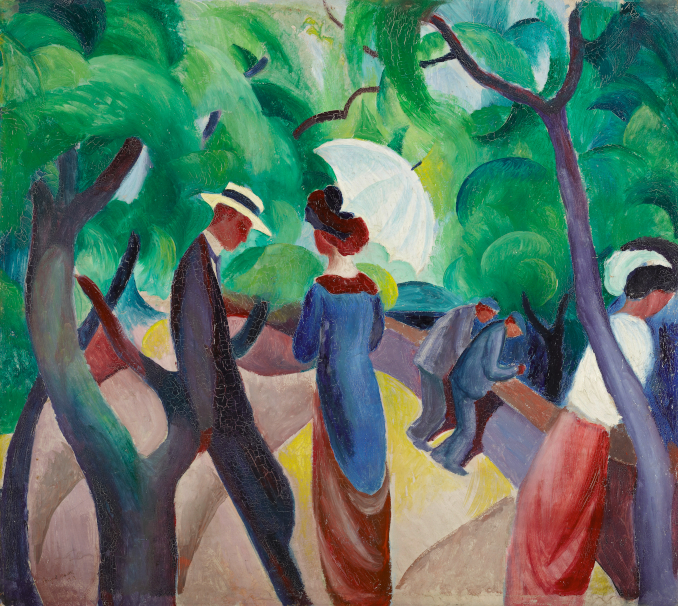
Within the Blue Rider group, Kandinsky worked most closely with his friend Franz Marc, who was perhaps the most original artist. Marc’s fascination with animals produced amazing canvases of tigers, horses, and even cows, painted with neon colors amid dream-like landscapes. Kandinsky was working with Marc on a book on theater arts when the course of European history was changed on June 28, 1914 by the assassination of Archduke Franz Ferdinand, which sparked a global war. Marc perished at Verdun in 1916; another stalwart of the group, August Macke, had been killed even earlier in September 1914. Kandinsky and Münter went into long exiles, while Werefkin and Jawlensky escaped to Switzerland. The Blue Rider group and its pioneering adventures with color had ceased to exist.
The exhibition of over 130 works, organized with the collaboration of Lenbachhaus Gallery in Munich, runs at the Tate Modern in London between April 25 – October 20, 2024.
